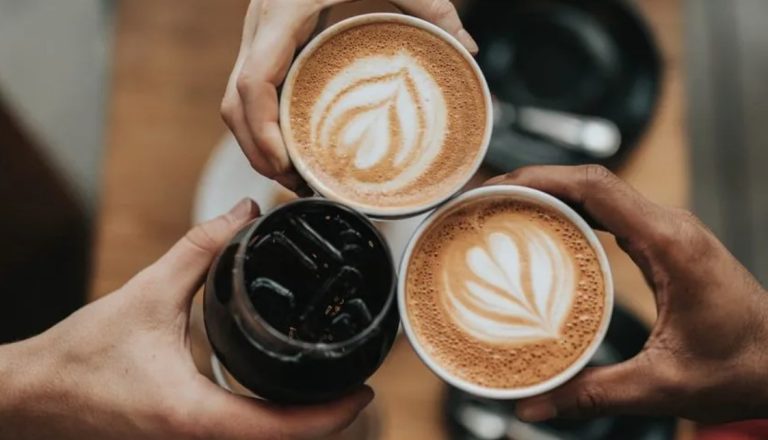According to a Statista forecast, 10.35 kg of coffee will be consumed per capita in Finland in 2017. Finland leads the statistics. The Finns prefer to drink filter coffee, not coffee from the coffee machine for the office. Since drinking coffee is so important for citizens, there are even legally regulated coffee breaks during working hours – 2 x 15 minutes a day. Light roasts are predominantly drunk, as these used to be cheaper than darker roasts.

The Dutch will drink around 9.58 kg in 2017, securing second place among the biggest coffee lovers. Unlike in Germany, the Dutch also drink coffee in the evenings. The filter coffee machine is also widespread, but the popularity of other systems such as capsule machines and fully automatic coffee machines for the office is also increasing. Like most coffee-drinking countries, the Netherlands also have their own coffee creations, e.g. the “Koffie verkeerd”.
This creation is similar to a latte – lots of milk and little but strong coffee. This coffee specialty is usually served in a glass. In general, one can say that the coffee cups at our neighbors are rather small.
According to the forecast, the Swedes will take third place with a coffee consumption of 9.4 kg. The word “fika” shows that drinking coffee is anchored quite deeply in the culture. It is often translated as “drinking coffee” or “coffee break”, but this does not convey the full meaning of the word. Fika is not for those in a hurry, as it represents a coffee culture that takes its time. You talk about everyday things, but also discuss problems and conclude contracts.
Usually there are also sweet pastries such as cinnamon rolls with the fika. You will rarely find a coffee-to-go from a fully automatic coffee machine in a commercial setting.
Denmark and Norway rank fourth and fifth in global coffee consumption with 8.16 kg and 7.76 kg respectively. The Danes like to drink a lot of coffee, preferably black. Even in the evening, the Danes do not refuse a coffee. The same applies to the Norwegians. Coffee is always drunk, even in the late evening hours.
With a coffee consumption of 7.33 kg per capita, Austria takes 6th place. In Austria, there is a strong coffee culture and coffee specialties with names that are sometimes unknown to us: Kapuziner, Einspänner, Großer Brauner, Melange, etc. In general, preparing portions in portions is very popular in Austrian households. Many people have capsule systems or a fully automatic coffee machine for the office. Especially the breakfast coffee is celebrated here. But it’s not about the caffeine kick in the morning, it’s about enjoying the coffee.
In Italy, espresso is considered “coffee”. Since the espresso is much smaller than a coffee, the per capita consumption – 6.69 kg – is also lower than in other countries. Thus, Italy reaches the 7th place among the greatest coffee lovers. Cappuccino and latte macchiato are popular for breakfast in the morning. After 11 a.m., most Italians only go for espresso. If you drink your coffee in a bar, you take it standing up. At home, almost every Italian has an espresso maker for the stove. Because espresso is the coffee drink in Italy, the darker roasts are more popular.
Around 6.65 kg of coffee per capita – 8th place – was consumed in Germany in 2017. The favorite variant of the Germans: filter coffee. Therefore, medium roasts are also the preferred roast degrees. However, more and more offices are purchasing fully automatic coffee machines for commercial use. In general, there are no rules or traditional behaviors in Germany when it comes to enjoying coffee. Everyone drinks their coffee the way they like it best: with milk, with sugar, strong or mild, decaffeinated – everything is allowed.
Whole beans, but also pads and capsules recorded sales growth in 2016. Even if other systems are becoming more and more popular, almost every German household has a filter coffee machine in the cupboard.
Estonia comes in 9th with around 6.48 kg, followed by Switzerland in 10th place with 6.31 kg. The Czech Republic is in 11th place with 5.01 kg of coffee per capita. Around 4.88 kg of coffee is expected to be consumed by every Irishman in 2017 – 12th place.
France secured 13th place with a per capita coffee consumption of 4.8 kg. France is best known for its café au lait, which is often drunk for breakfast and from a handleless bowl. The special thing about the café au lait: coffee and milk are poured in at the same time. Fully automatic coffee machines for the office can prepare this drink perfectly. At noon and in the afternoon there is often an espresso. If you watch your wallet, you can drink your espresso right at the counter. This is often more expensive outdoors.
In Greece – 16th place with a coffee consumption of 4.52 kg per capita – café frappé is a popular drink. This is a cold coffee that is very popular in summer. It consists of instant coffee, sugar and some water. This mixture is whipped with a frappe foamer or shaken in a cocktail shaker until foamy. Then ice cubes are added.

Even if you order a “coffee” in Spain, you lighten up an espresso. Accordingly, Spain only comes in 20th place with 4.25 kg of coffee per capita. The café con leche is similar to a milk coffee. When ordering, you may well be asked whether you would like cold or warm milk in your coffee. If you want a “bigger coffee”, you can order a café americano. Depending on this, it is filter coffee or an extended espresso from a commercial coffee machine.
Dark roasts are very popular in Spain. There is even a Spanish roast where sugar is added to the beans. The sugar coats the beans and caramelizes them. The coffee can be roasted longer, but it doesn’t taste as bitter.

